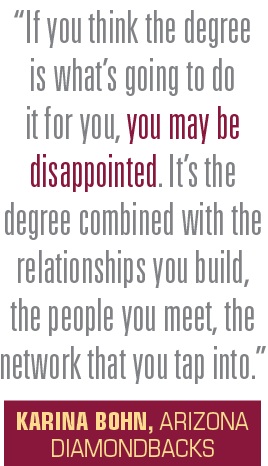When Karina Bohn chose to pursue her MBA at Arizona State, she was at a different life stage than most of her classmates. Married and in her early 30s, she not only knew she wanted a career in sports, but she knew she wanted to pursue it in the Phoenix area.
Bohn had worked with sports clients on the agency side. She hoped that an MBA from ASU would open the door to a job at one of the city’s pro franchises.
“Looking back on it, I wouldn’t change anything,” said Bohn, who is in her second season as the Arizona Diamondbacks’ vice president of marketing and 11th season in the club’s front office. “I look at where I am and I realize that the choice I made led to opportunities that I don’t think I’d have gotten if I hadn’t gone back to school.”
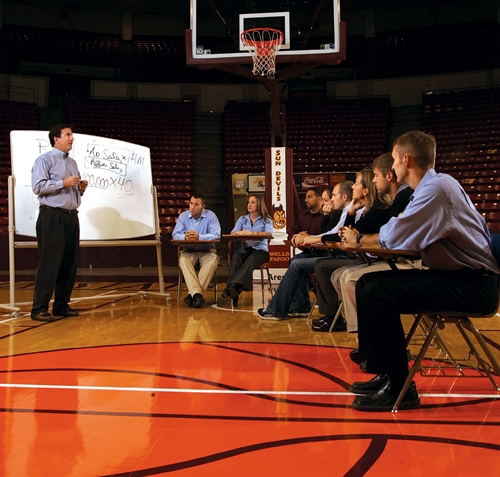 |
In this 2004 photo, Jim Kahler lectures students at Arizona State’s sports business program. Of the eight students shown, three work in sports today. Kahler now heads the sports administration program at Ohio University. ASU no longer offers the sports specialty.
Photo by: Jason Wise Photography |
When Mark Dunkerley left a job in marketing in the Vanderbilt athletic department to head to business school at ASU, he saw it as a chance to accelerate his advancement toward an athletic director’s job, while creating a “safety net” in the event that sports wasn’t working out.
He worked in the athletic department at ASU while getting his MBA, then landed a full-time gig as director of sports marketing there when he graduated. Soon after, Dunkerley added fundraising to his responsibilities. After three years, he’d seen enough to know the career wasn’t for him.
“Fundraising in college athletics isn’t fundraising, it’s ticket sales,” said Dunkerley, who for the last four years has split his time between heading up development for a Nashville nonprofit and launching and operating his own craft beer company. “Usually, donors are donors because they want good seats. ASU opened my eyes to the fact that maybe I was naive as to what college athletics really was. No knock on Arizona State, but it wasn’t for me.
“I got out of sports, but fortunately I still have the business degree. Ten years later, I’m glad I went that route.”
Student profiles: Click here for their stories and words of wisdom
Both Bohn and Dunkerley were featured in the pages of SportsBusiness Journal in November 2004, in the first of what has become an annual look at sports education. The story focused on sports business MBA programs at Arizona State and the University of Central Florida, following the students for an inside look at the curriculum while exploring what it was that drew them to pursue careers in sports. That issue also included snapshots of three other well-established programs that offered sports-focused MBAs: Ohio, Oregon and Massachusetts.
The students featured in that story had this in common: All said they saw a career in sports as a way to turn avocation into vocation. Checking in with them a decade later, all but one member of that ASU graduating class landed a job in sports, and eight of the 12 remain.
Andy Rentmeester is vice president of sales planning and analytics at MSG Sports. Kristin Shaff is director of
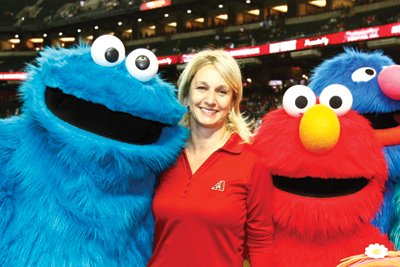 |
Karina Bohn, who is in her 11th season in the front office of the Arizona Diamondbacks, hangs out with Sesame Street characters that were part of a USO promotional tour.
Photo by: Arizona Diamondbacks / Jordan Megenhardt |
sponsor activation and business development for the San Francisco Giants. Jeremy Lange is vice president of marketing for a small NASCAR Sprint Cup team, Leavine Family Racing. AJ Maestas and classmate Stefanie Francis founded the sponsorship measurement company Navigate Research. Eyal Mintz started Fan Interactive Marketing, a company specializing in CRM. Bryan Finch teaches sports management at Oklahoma State.
The success rate for the graduating classes across the five programs in 2005 and 2006 — in essence, the students who were working toward their master’s at the time of our story — was nearly as high. Seventy-seven percent of the 203 students we were able to locate from those programs landed a first job in sports. Ten years later, 115 still are working in sports.
Twenty-five of those work in college sports, most of them as associate or assistant ADs. Twenty-one are in front offices at pro teams, most on the business side but a few in operations or player development. Sixteen are at sports marketing agencies. Seven are in sports sponsorship at large brands. Six are at sporting goods brands.
Because they entered programs that either had long histories funneling students into the industry or were headed by professors who had success doing that elsewhere, they were embarking on that quest with eyes wide open.
They had been told to expect to be paid far less than similarly qualified applicants in most other fields, at least at the start, and that they might well make less after getting their MBA than they made before it. That they needed to land high-quality internships and impress while there. And, perhaps most importantly, to make good use of alumni and guest speakers to develop a network.
A decade later, Bohn, Dunkerley and four other members of that ASU Class of 2005 reflected on the choices they made, and the paths their careers have taken.
All of them shared one jolt they never expected.
Five years ago, ASU, which at the time was the only nationally ranked business school in the country to offer a specialty in sports, announced that it was shuttering the program. With the economy in the tank and budgets tightening, it no longer could justify offering a specialization that offered such a short supply of jobs, most of which paid far less than those in other fields.
Turns out ASU’s business school wasn’t cut out for sports, at least not long term.
Not everyone is.
No regrets
Lange was wrapping up a quick call from a sponsor on a recent Wednesday morning when the race team’s crew chief poked his head into the office to let Lange know he’d be ducking out for a bit.
“Gotta meet the plumber,” he said.
Lange nodded and waved.
The larger operations in NASCAR have upward of 100 employees, with layers of engineers, mechanics, crew
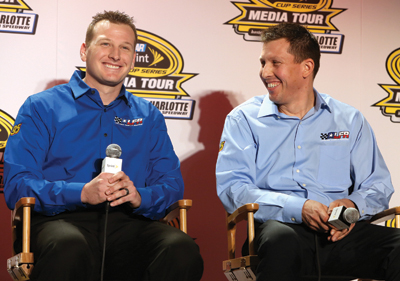 |
Jeremy Lange (right) has found a home with NASCAR Sprint Cup team Leavine Family Racing. Here he’s joined by the team’s driver, Michael McDowell, during a media tour.
Photo by: Harold Hinson Photography |
members and executives that sell and service sponsorships for multiple race teams. Leavine Family Racing has one Sprint Cup team and 15 employees. The crew chief oversees everything to do with the car. As vice president of marketing, Lange manages everything else.
“I couldn’t be any happier than where I am,” said Lange, who joined the team a year ago after stints in race sponsorship with agency GMR and for Best Buy. “I like being with the underdog, the David and Goliath kind of thing. And I like having a say in what goes on and feeling like I make a difference.”
Lange knew coming out of ASU that racing would be his likely path. He had interned at NASCAR’s New York office, researching sponsor targets and helping organize contract information to track the order in which various deals were expiring. He wasn’t a race fan, but he was intrigued by the way the business worked. So when he got the opportunity to join a startup race team that would be “owned” by fans — a database marketing company disguised as a stock car team, really — he jumped at it, relocating to Sarasota, Fla.
The company had $4.5 million in seed money, enough to last three years while the idea got off the ground, Lange thought. It burned through the money in 21 months, shuttering without ever running a race, or even building a car.
Lange needed to find another job.
Lange landed a slot with a sports marketing company, working on Kroger’s NASCAR sponsorship. That led to an
offer from well-regarded GMR, handling sponsor Jim Beam’s program. From there, he moved to Best Buy’s NASCAR account and developed a model to track the ROI that the sponsorship delivered for Best Buy’s business-to-business division.
“One day, the guy who ran the program on the Best Buy side said, ‘Would you mind coming over here and running this for us, because I have no idea how to do it,’” said Lange, who became a national account manager at Best Buy.
“I’d always wanted to get to the client side, and it was a roundabout way of getting there. It was great.”
Great, until Best Buy went through a deep round of layoffs. For the third time in seven years, Lange found himself looking for a job.
The good news, as he sees it now, is that each of those career moves put him on a different side of the sponsorship equation. He’d been at a race team, an agency and a brand. He thought about hanging out his own shingle, but with two young children couldn’t stomach the risk.
Lange started mining his network — a practice that program director Jim Kahler always stressed to his students. An attorney he met while working on Best Buy connected him with Bob Leavine, who was looking for someone to sell sponsorships for a part-time Sprint Cup entry.
Lange pointed to a dry erase board on his office wall, explaining the color coding that charted which races they have sold to sponsors, which were unsold and which lived somewhere in between. “I really like what Bob and Sharon [Leavine’s wife] are trying to do with this race team,” Lange said. “We’re building something.”
Walking back through his career path, the conversation turned to where he might be without his sported-up MBA.
He was working on the media side of a New York ad agency before he went back to school. It had clients in sports. Yes, he says, it’s likely that he could have crossed from there to a brand, or to a sports marketing agency.
You won’t find “MBA preferred” on any race team job postings.
“Trust me, I think about it all the time,” Lange said, nodding. “Could I have made money instead of spending money for two years and still be where I am today? Absolutely. But would I have found the motivation or the confidence to do it? Probably not.
“I figured out a lot while I was at Arizona State. My résumé doesn’t even say sports business on it. But I’m glad I did it. Looking back, I wouldn’t change it for the world.”
Earning your stripes
Five months into a job as director of sponsor activation with the San Francisco Giants, Shaff has, like Lange, seen all three sides of the sports marketing triangle.
Her first job after ASU was with GMR, working on Visa’s sponsorships, which exposed her to a range of properties, including the NFL and the Olympics. She moved to the client side after five years, when her contact at Visa left to become CMO at 24 Hour Fitness and hired her to manage the company’s Olympic relationships. She was there until March, when she took her job with the Giants.
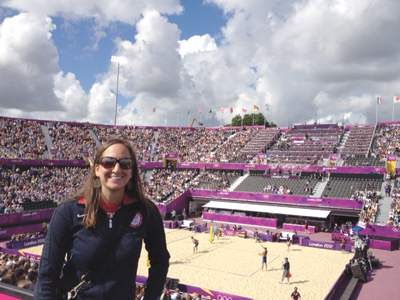 |
Kristin Shaff worked on the agency side and brand side before joining the San Francisco Giants as director of sponsor activation.
Photo by: Kristin Shaff |
Agency, then brand, then property. Shaff said that she has enjoyed all three, but that it differs from what she envisioned while in business school.
“When we were in school, we all thought we were going to be involved in strategy and spend our days coming up with cool marketing ideas,” Shaff said. “And, fortunately, you do some of that. But on the agency side, you’re a recommendation maker and not a decision maker. You learn that pretty quickly. On the corporate side, you may be a decision maker, but you spend a lot of time in budget meetings and doing things like talking to HR, so 75 percent of your time is being pulled by the bureaucracy of the organization.
“Then, on the team side, people have this perception that you have the coolest job in the world. And it can be great.
This is a really rare chance to work for an organization where people never leave, learning the team side at one that arguably does this better than anyone. But do you know what I do? It’s like anything else. You come in. You answer emails. You go to meetings. It’s no different than what most people do. We just happen to go down to the field before the game.”
Like several of her classmates, Shaff said she is unable to draw a correlation between her MBA and her career path.
“I don’t think it matters, unfortunately,” Shaff said. “I wish it did. The industry still has an old-school view of education, and of paying your dues. When you’re at the director level at a company it helps. It helped me at 24 Hour Fitness, because all my peers had the MBA as well. But I don’t know how it helps if you’re at a team or league, because you’re still going to be expected to earn your stripes and work your way up.
“At least none of us can say that’s something that we weren’t told about.”
None of the half-dozen ASU grads interviewed for this story said the MBA helped them land a job or advance, at least not directly, although all agreed that the skills and approaches they learned in business school have made them better at their jobs.
Their consensus was that it was worthwhile, but not at all appreciated in sports, other than during stints some of them had in the corporate world.
“I don’t think the MBA factored into my being promoted quickly,” said Bohn, who went from intern to director of marketing in only two years, but attributed that mostly to her experience level and performance rather than her education. “If you think the degree is what’s going to do it for you, you may be disappointed. It’s the degree combined with the relationships you build, the people you meet, the network that you tap into. If you come out with the degree, but no relationships, no internship, not having proven to anyone but yourself that you can add value to an organization — it’s not really worth that much.”
Building a network
Kahler, the Ohio alum who ran the ASU program and now heads the fabled sports administration program at his alma mater, answers quickly when you ask him to help locate his former students.
“I’ll get you what I have, but you should really talk to AJ,” Kahler said, referring to AJ Maestas, who impressed both his professors and his fellow classmates with his ability to build contacts while at ASU. “He’ll know where everybody is. AJ is all about the network.”
Maestas chuckled when told that. Kahler always stressed the value of networking, which is a strength at both Ohio
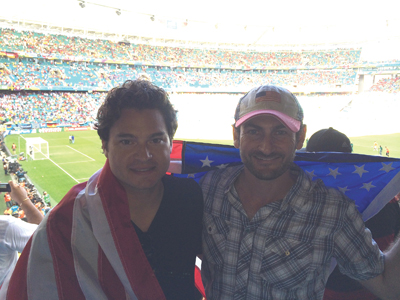 |
AJ Maestas (left) founded a sponsorship measurement company while Dave Schifrin ventured in and out of sports. He now works for a Phoenix-based athletic training company.
Photo by: AJ Maestas |
and UMass, where the alumni tentacles reach deep and wide in sports.
He did well in the classroom, but his emphasis was elsewhere. All the ASU students collected business cards when at networking events and followed up with notes to the people they met. But Maestas was almost manic about it. He thought more about volume than about impressing anyone on the spot, figuring that the only real chance he had to do that would come later.
“Not that an MBA didn’t help, but my investment in ASU was entirely to open doors in sports and I treated it that way,” said Maestas, who is president of a sponsor research company that he launched with an ASU classmate and also teaches an online course through Ohio. “My focus was on things like internships and networking, and on learning what roles and functions existed and what the path was.
“I hate saying this, because ASU was a very good MBA experience. But it was really what Jim Kahler gave me that I was seeking. Not only is he passionate about selling his students to the marketplace, but he came connected to the Ohio University family, which is an incredibly powerful network. That gave me the academic experience of Arizona State and kind of cheated me into the Ohio network.”
Maestas was passionate about sports, but he understood that there were limited opportunities and knew that the pay could be far less than he could make elsewhere, at least at the start.
While most of those who have remained in sports agree that the MBA is generally unappreciated, or at least underappreciated, by those hiring and promoting, those who crossed over see it differently.
“It’s not just a matter of having it, it’s having it instead of just the sports [administration] degree,” Dunkerley said. “I look back at my choice with absolutely no regrets, mostly because of the MBA. The sports isn’t really doing me much good right now. But when you’re looking to do something else, the MBA can.”
Working on the fringes
When Dunkerley, Maestas, Bohn, et al., were in their second year at ASU, Dave Schifrin was in his first. He was one of the few students who, like Dunkerley, left a job in sports to pursue his MBA. Schifrin was working for Richard Motzkin, a prominent soccer agent. He thought the MBA would give him a leg up in the sport.
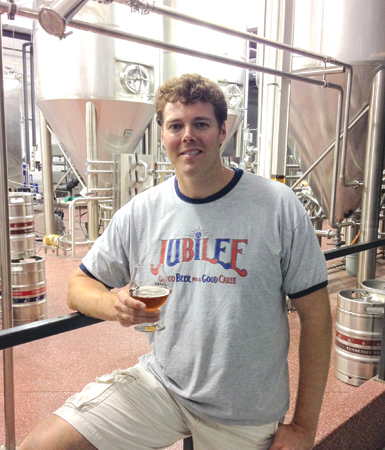 |
Mark Dunkerley once had his sights set on college sports, but he used his business skills to launch a craft beer company.
Photo by: Mark Dunkerley |
At the time, Kahler thought Schifrin might one day end up as the commissioner of MLS. But Schifrin didn’t want to build on his soccer résumé while at business school. He used his internship to work at the fringes of the industry, at a pharmaceuticals company that wanted to do more sports marketing.
Schifrin decided he would enjoy something like that more than a job with a team, league or agency. When he graduated, his job hunt didn’t go well. That’s when he got back in contact with Dan Burns, the COO of a Phoenix-based athletic training company for which he had worked on a project while at ASU. Burns offered him a job in operations, which meant “doing everything.”
“It was at the fringes of sport, and I learned quickly that that’s the right place for me,” Schifrin said. “Supporting the athletes is what I like. And that was a great place to do it.”
Over the next three years, the company took on private equity investment and expanded. But when the economy tanked, it hit a rough spot. Schifrin was laid off.
The next few years of his résumé are a checkerboard. He ran a successful, small chain of yoga studios that was sold to a larger chain. He did agency consulting. He tried the travel business, leading tours through Alaska.
Last year, at 38, he decided he wanted to get back on path. So he returned to the Phoenix-based athletic training company, which is now a more broadly positioned wellness company called EXOS.
Schifrin spends most of his days looking for ways to collaborate with partners such as the Mayo Clinic on programs to enhance employers’ health and wellness programs.
“It took a while, but I’ve really found where I fit,” Schifrin said. “I’d say I’m still in sports, but it’s definitely on the fringe, which is what I like.
“When I get asked for advice by kids who want to work in sports, I tell them to get a solid MBA and forget the
sports stuff. You’ll be able to do sports-related projects at any MBA program. So go learn about GE and Starbucks. Get involved in a sports business club that brings in guest speakers. Get an internship in sports.
“I tell them they can get the sports anywhere. It’s just a matter of figuring out what the jobs are and putting in the effort. The thing that’s of value is the MBA.”
Schifrin wasn’t the only one of the ASU grads to say that. Those who disagreed pointed out that, for someone who has no ties to the industry, the sports part — and especially making connections to land internships and find a desirable job — might be difficult to navigate without a more established infrastructure.
“I’m not sure where you’d get that in most traditional MBA programs,” Maestas said. “I know I’m not doing what I’m doing today if I hadn’t gone to ASU and made the connections to Ohio.”
While they didn’t agree on some points, all the ASU grads interviewed said they look back fondly on their experience there.
Ten years after their time in school, learning to analyze and strategize, to assess and direct, each of them calls their decision to chase a career in sports the right one, with a caveat.
“It was the right way to do it, but it turned out it wasn’t the right path for me,” Dunkerley said. “The big thing people need to understand when they say they want to work in sports is that, at some point, it does become a job. At some point, you get numb to all the cool things. At some point, all things being equal, you might just as soon be at home with your family or out with your friends as opposed to being at another event.
“That’s the thing you’ve got to look at. For me, what was cool at 24 and what’s cool now are vastly different.”




